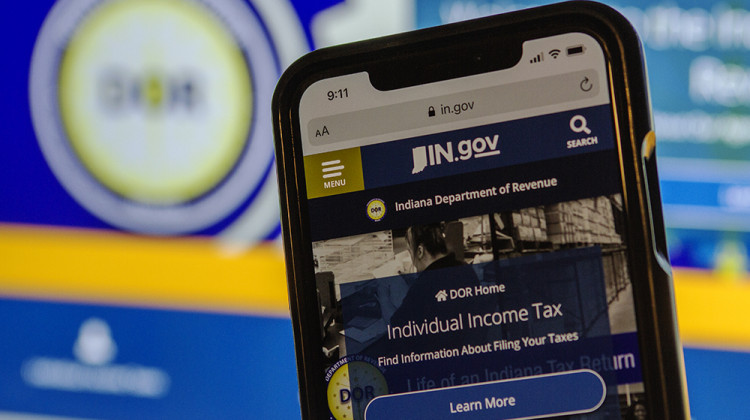
In addition to the federal credit, 30 states have designed their own statewide version of an earned income tax credit. Most of them, including Indiana, calculate that credit as a percentage of the federal credit.
Doug Jaggers/WFYIJust shy of one million people in Indiana live below the poverty line. One policy designed to help is the earned income tax credit, or EITC. This past legislative session, Indiana increased its earned income tax credit from 9 percent to 10. But how does it work, and what might it mean for working families?
The Basics
The earned income tax credit gives low-income people unrestricted cash to spend on whatever they need. To be eligible, you need to earn money through a job -- hence the name “earned income” -- but still live close to the poverty line. For example, a single adult without kids would make just shy of $16,000 a year to qualify. Depending on how many kids you have, the baseline income goes up from there, all the way to $57,414 for a married couple with three or more children.
Recent data show about half a million taxpayers claim the federal earned income tax credit in Indiana each year. Money that the federal government gives those families funnels more than a billion dollars into the state’s economy.
According to Jessica Fraser, director of the Indiana Institute for Working Families, unrestricted cash is very helpful for families living near the poverty line, because it allows them to spend that cash on basic needs.
“They need to put gas in their car, they need to buy personal hygiene products and band aids and aspirin,” she said. “They need cash.”
In addition to the federal credit, 30 states have designed their own statewide version of an earned income tax credit. Most of them, including Indiana, calculate that credit as a percentage of the federal credit. For example, if a family qualified for a $100 federal earned income tax credit, they would get another $9 from the state of Indiana.
Next year, with the one percent increase, that will go up to $10 for the same family.
The most money a family can get from Indiana’s earned income tax credit right now is $533. With the recent boost, that will add an extra $53 from the state of Indiana.
Fraser said, that’s not nothing -- enough for diapers for a month, or to pay the electric bill. And taken together, the tax credit can make a difference in people’s lives.
“If you're one of those people that’s right on the cusp between poverty and non-poverty, $500 could be enough to lift you out,” she said.
History and Challenges
Research shows that the earned income tax credit is one of the most successful anti-poverty credits the government offers, in part because it motivates people to stay in the workforce and continue earning an income.
Take a single mother who might qualify for other kinds of assistance programs if she chose not to work. If her state’s earned income tax credit is high enough, she can take a low paying job and actually come out ahead.

There’s also data that indicate the EITC has a positive effect on infant and maternal health, as well as childhood educational outcomes.
As a result, lawmakers across the country lean into the tax credit as a tool to combat poverty and its effects. Washington, D.C.’s credit is four times as large as Indiana. Here, lawmakers don’t lean in as much -- in fact, Indiana’s EITC is among the lowest in the country.
Political scientist Andrew Downs, who directs the Mike Downs Center for Indiana Politics, said it has to do with lawmakers’ views on welfare programs.
“You will almost never find Indiana out at the far reaches of any sort of a program that might be in any way, shape or form, considered to be welfare,” he said.
Downs noted that Indiana falls in the middle of the region for the size of it’s EITC. Michigan’s is 6 percent, while Illinois is 18 percent. Ohio’s is the highest at 30 percent, though it’s credit is non-refundable -- meaning, it can only be used to offset existing taxes and can’t be redeemed as unrestricted cash.
“There are some folks in the state who believe very strongly that any program like that is something that should be done through community organizations and faith based organizations,” Downs said. “But at the same time, the government has recognized over the years, that's really not feasible.”
And there’s also a complicated history to Indiana lawmakers’ relationships to the EITC. During the Great Recession a decade ago, the federal government decided to expand the earned income tax credit, in an effort to close a penalty for married couples as well as increase benefits for families with three or more children.
But because Indiana’s EITC is structured as a percentage of the federal credit, the federal expansion would have forced the state to increase its own payments of the EITC. So, the state decided to decouple its credit from the federal expansion -- essentially creating a loophole in which any state payouts of the EITC must refer back to the old federal guidelines.
That means, there’s still a marriage penalty in Indiana, and there are no extra benefits for families with three or more children. Fraser said that the decoupling makes filing for the credit more complicated.
“If you do your taxes by hand, there's literally like a whole packet of stuff that you have to go through,” she said. “There’s like a form, and a big section of the booklet and a whole separate table for calculating out your state EITC.”
But some mayors and local tax clinics make an effort to help low-income families file the paperwork necessary to claim the credit. For one, it can help those families access critical cash. But Downs said, it can also help the regional economy.
“When that check shows up, it gets rolled into the economy very quickly,” he said. “Folks are more than likely going to spend it -- and spend it locally.”
That means even a small increase to the EITC can go a long way. But that assistance has a fiscal impact. Increasing the state’s EITC by just one percent this year will cost the state somewhere between $10 million and $12 million each year.
Why Increase Now?
This year’s expansion to the EITC came as a kind of compromise for not increasing a different assistance program -- TANF, or temporary assistance for needy families.
Rather than broaden Indiana’s TANF eligibility requirements, the legislature decided to expand the state’s earned income tax credit instead. Downs said it comes back to how the legislature views welfare-like assistance programs.
“The earned income tax incentives work, that’s what it’s supposed to do,” said Downs. “Whereas TANF is viewed, rightly or wrongly, strictly as a handout.”
For advocates for low-income families like Fraser, that trade-off was initially a tough pill to swallow. But she said she’s made her peace with it -- and hopes the EITC will continue to grow.
“I do see that it is a benefit for so many Hoosiers,” she said. “It's not a ton of money, but it can help pay for some of those small expenses that families can't pay for. So I’m happy about it for that reason.”
 DONATE
DONATE






 Support WFYI. We can't do it without you.
Support WFYI. We can't do it without you.